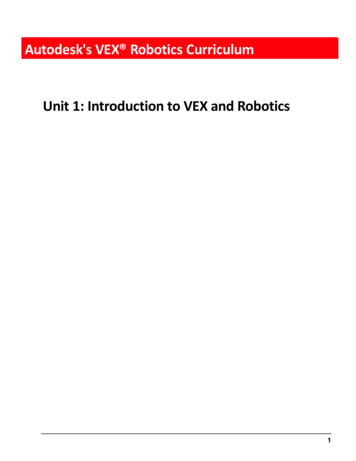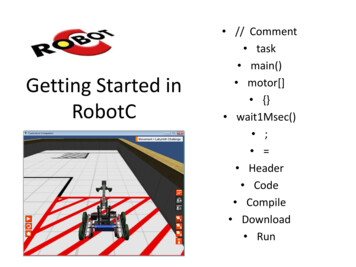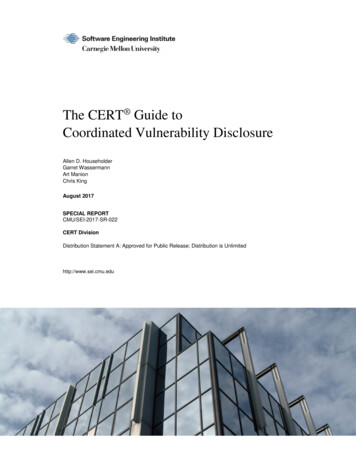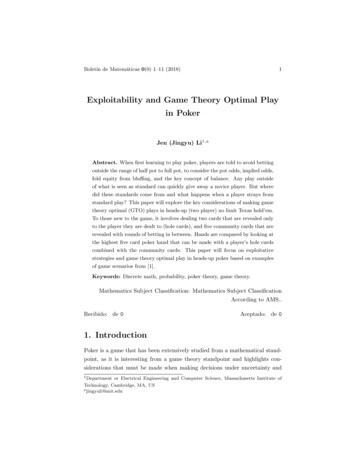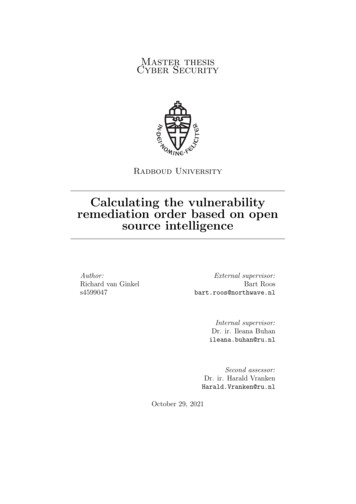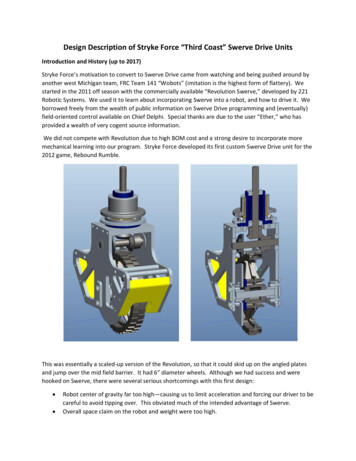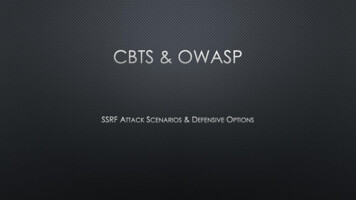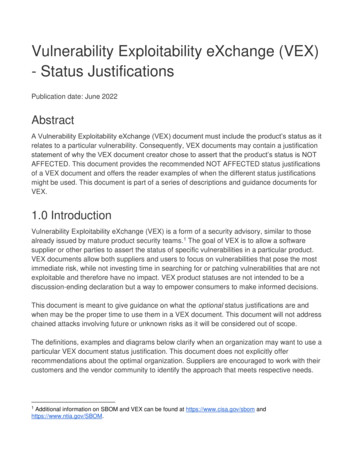
Transcription
Vulnerability Exploitability eXchange (VEX)- Status JustificationsPublication date: June 2022AbstractA Vulnerability Exploitability eXchange (VEX) document must include the product’s status as itrelates to a particular vulnerability. Consequently, VEX documents may contain a justificationstatement of why the VEX document creator chose to assert that the product’s status is NOTAFFECTED. This document provides the recommended NOT AFFECTED status justificationsof a VEX document and offers the reader examples of when the different status justificationsmight be used. This document is part of a series of descriptions and guidance documents forVEX.1.0 IntroductionVulnerability Exploitability eXchange (VEX) is a form of a security advisory, similar to thosealready issued by mature product security teams.1 The goal of VEX is to allow a softwaresupplier or other parties to assert the status of specific vulnerabilities in a particular product.VEX documents allow both suppliers and users to focus on vulnerabilities that pose the mostimmediate risk, while not investing time in searching for or patching vulnerabilities that are notexploitable and therefore have no impact. VEX product statuses are not intended to be adiscussion-ending declaration but a way to empower consumers to make informed decisions.This document is meant to give guidance on what the optional status justifications are andwhen may be the proper time to use them in a VEX document. This document will not addresschained attacks involving future or unknown risks as it will be considered out of scope.The definitions, examples and diagrams below clarify when an organization may want to use aparticular VEX document status justification. This document does not explicitly offerrecommendations about the optimal organization. Suppliers are encouraged to work with theircustomers and the vendor community to identify the approach that meets respective needs.1Additional information on SBOM and VEX can be found at https://www.cisa.gov/sbom andhttps://www.ntia.gov/SBOM.
2.0 Status Justifications OverviewVEX documents must contain the following information: VEX metadata, product details,vulnerability details, and product status. Product status details include status information abouta vulnerability in a product and must be included in the document as one of the following: NOTAFFECTED, AFFECTED, FIXED, and UNDER INVESTIGATION2.A VEX document’s product status details may also include a status justification in an optional,machine-readable field. A status justification will help consumers understand thecircumstances under which an assertion was made that a product is NOT AFFECTED.3Here is a list of the NOT AFFECTED status justifications: Component not present Vulnerable code not present Vulnerable code cannot be controlled by adversary Vulnerable code not in execute path Inline mitigations already existStatus justifications fields, like all fields in VEX documents at this stage, are assertions madeby the author of the document, either the product supplier or any other party. The attestation isdesigned to be machine readable. Like all assertions, the consumer of the VEX document maychoose to accept it or not. The goal of these status justifications is to offer more context anddetail about these claims, in a machine-readable fashion, to facilitate trust and allowautomated policy-based actions by the user.VEX documents and status justifications are based on specific known vulnerabilities. Manyattackers use chains of vulnerabilities to exploit a system. The assertions in a VEX document,including the status justifications laid out in this overview, are built around known risks tosoftware and components. New vulnerabilities may emerge, which could affect a product.2The VEX product statuses are defined in the VEX Use Cases document found tions/VEX Use Cases Aprill2022.pdf.3Information about other optional, machine-readable fields to justify additional product statuses (i.e., AFFECTED,FIXED, and UNDER INVESTIGATION) will be the topic of future VEX Working Group documents.
3.0 Status Justification Definitions, Diagrams &Examples3.1 Status Justification IntroductionThe following sections illustrate the pre-defined status justification field values in detail. Statusjustification values and use cases may be difficult for non-developers to understand, so it maybe helpful to review the flowchart below to determine which of the use cases applies to a givenstatus justification assertion. The flowchart illustrates the key factors that contribute to statusjustifications and suggests the correct value that applies. If none of these factors are present,the flowchart identifies when the pre-defined status justification values cannot be applied.
VEX Status Justification Decision Flowchart
3.2 Status Justification DiagramsReaders may find the status justification diagrams throughout the document helpful in visuallyunderstanding the status justification definitions for NOT AFFECTED product statusassertions. The diagram below is an example of an AFFECTED software product and showsthe reader the general layout of all diagrams and includes a color-coded legend forunderstanding whether a component is vulnerable or not vulnerable and whether there is amitigation present within the execution path.3.3 Component not presentThis status justification may be used when the product is not affected by the vulnerabilitybecause the component is not included in the product. The status justification may be used topreemptively inform product users who are seeking to understand a vulnerability that iswidespread, receiving a lot of attention, or is in similar products.
3.3.1 “Component not present” ExamplesExamples of this status justification include: The product is written in Python and Elixir and does not have any Java code present;therefore, the product could not be affected by the Log4j vulnerability. Because Java JAR files often contain other JAR files, automation may incorrectly flag acomponent as existing in a JAR file without verifying it as actually present. Base layer container images often contain unused packages. A later layer could removeone or more of these packages. A container image may be expected to contain ‘sudo’but it was removed prior to deployment.3.3.2 “Component not present” Diagram3.4 Vulnerable code not presentThis status justification may be used when the product software is not affected because thecode underlying the vulnerability is not present in the product. Unlike the
“Component not present'' status justification, the component in question is present, but thespecific code causing the vulnerability is not present in the component.3.4.1 “Vulnerable code not present” ExamplesExamples of this status justification include: The compiler has stripped out the relevant function. The vulnerable code may have been added in a later version of a component and is notpresent in the version shipped in the product.3.4.2 “Vulnerable code not present” Diagram3.5 Vulnerable code not in execute pathThis status justification may be used when the vulnerable code can never be executed in thecontext of the application. This situation can occur when third-party libraries are included butwhere the application only uses a fraction of the library functions directly or indirectly. A single
path of execution should not be assumed since the attacker may be able to divert the path ofexecution.3.5.1 “Vulnerable code not in execute path” ExamplesExamples of this status justification include: An old library ships with the distribution but is not invoked by the software. A vulnerability in a binary has been patched, but the unpatched binary remains for “rollback” purposes. In a container image, there will be operating system utilities that are not used by theapplication deployed inside the image. Those utilities cannot be removed from thecontainer image and are not used by the deployed application in any way. Included libraries often have many functions. A vulnerability in a library in a function thatis never called directly or indirectly also has this status. Applications that only usedOpenSSL for secure random function were not vulnerable to the Heartbleed protocolvulnerability which was never called from secure random. The code is only executed by a hardware module that is not installed.3.5.2 “Vulnerable code not in execute path” Diagram
3.6 Vulnerable code cannot be controlled by adversaryThis status justification may be used when the vulnerable code cannot be controlled by anattacker to exploit the vulnerability without exploiting at least one other vulnerability. Thevulnerable component is present and the component contains the vulnerable code. However,due to some other circumstances, the vulnerability in question cannot be exploited by anattacker.3.6.1 “Vulnerable code cannot be controlled by adversary” ExamplesExamples of this status justification include: A hard-coded variable that denies user-generated input for the vulnerable function. A logging facility that is only called as a result of hardware malfunction or duringinstallation. Software is vulnerable to the EternalBlue vulnerability, but SMB ports 139 and 445 aredisabled, and the user does not have access to the O/S to enable the ports. Thevulnerability cannot be exploited by an attacker because the ports are unavailable. Noadditional action is required by the operator.
3.6.2 “Vulnerable code cannot be controlled by adversary” Diagram3.7 Inline mitigations already existThis status justification may be used when the product includes built-in protections that preventexploitation of the vulnerability. These built-in protections cannot be subverted by the attackerand cannot be configured or disabled by the user. These mitigations completely preventexploitation based on known attack vectors.Note: Mitigations are effective only in the scenario where the threat model of the softwareallows it to perform its protections successfully. A mitigation which negates a vulnerability inone software/service may not necessarily be the case in another software/service.
3.7.1 “Inline mitigations exist” ExamplesExamples of this status justification include: Code sanitizes input further upstream. Sandboxing using memory separation techniques through software or hardware. Output and effects of the component that uses vulnerable code is verifiable. A buffer-overflow due to multiplication does not occur if one of the two argumentsalways evaluates to 1. Software is vulnerable to the EternalBlue vulnerability and the SMB port is enabled, butthe device integrates a firewall configuration that prevents network access to the ports.The user does not have access to the firewall to change the configuration to allow thecommunication. The device firewall provides inline protection by blocking access to theport. No additional action is required by the user.3.7.2 “Inline mitigations exist” Diagram
3.7.3 - Difference between“Vulnerable code cannot be controlled by adversary” and“Inline mitigations already exist”The status justifications “Vulnerable code cannot be controlled by adversary” (see section3.6) and “Inline mitigations already exist” (see section 3.7) are similar, but with some keydistinctions. In both cases, the vulnerable code is in the product, and may be expected to beexecuted. Thus, both rely on an expert analysis of the structure of the code to determine thatthe product is, in fact, not affected.However, when the code cannot be controlled by the adversary, the assertion is that there isnothing that the attacker can do to influence the execution of the code to trigger thevulnerability. Alternatively, when mitigations already exist, the adversary may influence theexecution of the code to trigger the vulnerability, but some other control blocks maliciousexecution. Mitigations that cannot be subverted or modified by attackers or users completelyprevent exploitation. As an example for section 3.6, the inputs to a function may not be usercreated, while in section 3.7, the user-created string is sanitized elsewhere within the product.4.0 Document FeedbackIf you have any feedback on the contents of this paper, please send us your thoughts atSBOM@cisa.dhs.gov. Your feedback will be extremely valuable to us in making continuousimprovements to the paper. VEX documents are starting to be used across the softwareecosystem, and the concept will continue to be refined as implementers and adoptersencounter new challenges and opportunities. Furthermore, this document does not contain anexhaustive list of status justifications and future work may contain new status justifications asdemand arises.Appendix A: About this documentThis document was a product of the VEX Working Group, which grew out of the NTIAMultistakeholder Process and the Framing Working Group, initially beginning work in 2020.That work continued into 2022, facilitated by CISA.Participants included:Allan Friedman, CISAArt Manion, CERT/CCBrandon Lum, Google
Bruce Lowenthal, Oracle CorporationBryan Cowan, Fortress Information SecurityCharlie Hart, Hitachi America Ltd.Chris Campbell, SolarWindsDerek Kolakowski, FoxGuardDerek Kruszewski, aDolus Technology Inc.Dmitry Raidman, CybeatsDuncan Sparrell, sFractal ConsultingEd Heierman, AbbottEliot Lear, Cisco SystemsDr. Hans-Martin von Stockhausen, Siemens HealthineersIvana Atanasova, VMwareJeremiah Stoddard, INLJim Jacobson, Siemens HealthineersJosh Bressers, AnchoreJustin Murphy, CISAKate Stewart, The Linux FoundationMatthew Paulsen, Juniper Networks, Inc.Michael Hoover, INLNisha Kumar, OracleRich Steenwyk, GE HealthcareSteve Springett, OWASPThomas Schmidt, Federal Office for Information Security (BSI) GermanyTimothy Klett, INLTimothy Walsh CISSP, Mayo ClinicTom Alrich, Tom Alrich LLCTony Turner, Fortress Information SecurityOthers participated, but do not wish to be named. Input into this document and the broaderVEX effort included feedback from multiple presentations, with a particular appreciation forfeedback from the Healthcare SBOM PoC community.
3.0 Status Justification Definitions, Diagrams & Examples. 3.1 Status Justification Introduction . The following sections illustrate the pre-defined status justification field values in detail.

